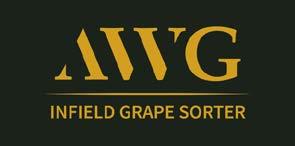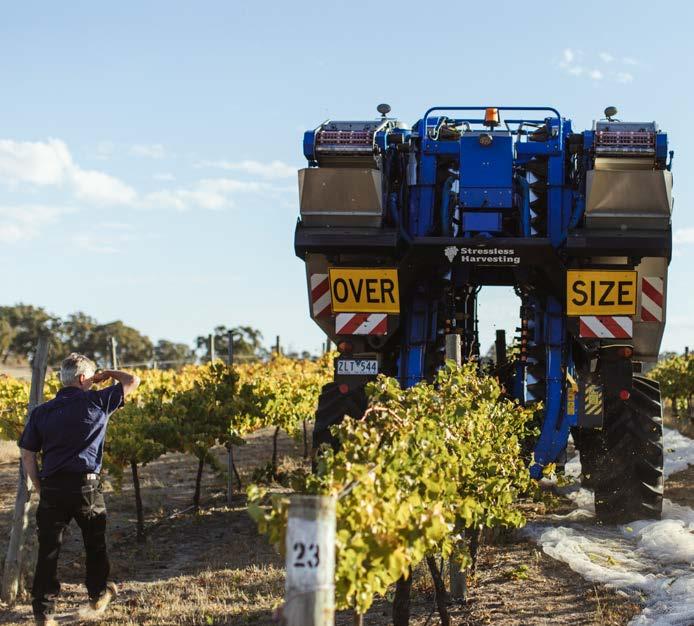
10 minute read
Technology keeping Best’s a step ahead
Earlier this year, writer Mark Smith visited Best’s Wines in Victoria’s Grampians to learn firsthand about what’s reportedly the first-use in Australia of some new and advanced vineyard equipment. The adoption of this tecnhnology has resulted in cost savings as well as further benefits for the vineyard environment.
Dynamic,’ ‘innovative’ and ‘forward-looking’ are not usually the kinds of words you’d expect to sit comfortably alongside ‘fifthgeneration wine producer’ and ‘custodian of a 150-year-old vineyard.’ But Ben Thomson isn’t your average vineyard manager and contract grape harvester. He’s also managing director of Best’s Wines in the Grampians region of Victoria.
“I’m a really strong believer in the future of this place,” Thomson says. “Great Western is among the smallest and most under-rated of Victoria’s wine subregions. It’s almost been forgotten until recent times. I’m really determined to showcase its strengths.” Having owned Best’s since 1920, his family has never been one to simply bask in the reflected glory of earlier successes, Thomson adds. Indeed, it isn’t even content with just moving with the times.
“We want Best’s to be at the pointy end of the industry,” he insists. “That means being forward-looking and innovative. The industry as a whole has got to do what broad acre agriculture has done over recent decades — become early adopters of new technology. “Australian viticulture has been resting on its laurels for far too long. We haven’t done anything different and exciting for years. Sure, there are risks associated with new ways of doing things, but where there’s risk there’s also reward. New technology will allow us to get better at growing premium fruit and make better quality wines. Small producers can’t survive by doing anything else.” Thomson speaks from experience. In addition to managing Best’s, he owns and operates Stressless Harvesting. The company is a busy vineyard contractor that picks parcels of premium wine grapes each vintage across a handful of phylloxera-free regions in Victoria, New South Wales and South Australia. He says vineyard management — especially pruning, canopy management and harvesting — has become particularly time sensitive given the changing climate, modern winery requirements, and industry trends in precision viticulture. That noted, demands for skilled labour and the costs of putting workers on the ground often pose significant challenges for small or remote vineyards. Great Western is 225 km north-west of Melbourne.
Stressless Harvesting’s Ben Thomson directing vintage traffic flow. Photo: Wine Australia
Ben Thomson



Vineyard workers, Best’s Nursery Block, circa 1860s. Photo: Best’s Wines

When Thomson established Stressless Harvesting back in 1998, it was smallscale and hands-on, with conventional secateurs the tool of choice. Today, its core business is tied to meticulously planned operation of a fleet of 10 mechanical harvesters. Each was designed and manufactured in France by Braud New Holland. A veteran of more than 40 vintages, Thomson says they are a far-cry from first-generation harvesters that entered the industry in the 1970s and 1980s. Modern technology is now capable of doing much of what was traditionally done by hand, only faster, and without compromising fruit quality or valuable vineyard infrastructure.
Lowering harvest costs
Harvesting costs per hectare can be much less than those achieved with manual labour. The downside is capital investment required for mechanisation is often difficult to justify. Thomson’s client vineyards include all three sites around Great Western owned by Best’s. They span 153ha of productive vines.
The Thomson family’s 22ha Concongella Vineyard includes the celebrated 1.2ha Nursery Block, a haphazard mix of heritage plantings, dating back to 1866. Seven of its vines possess DNA that is truly unique to them. Unidentified and unrelated vinifera selections, each appears to be the last of their kind anywhere on the planet. Extreme age and fragile vine architecture makes Nursery Block vines ready candidates for hand-picking. Elsewhere on the historic property, Shiraz and Riesling planted in the 1960s and 1970s are machine harvested without issue.
Braud is Thomson’s preferred manufacturer for good reason. Its engineers are demonstrably supportive of his proactive approach to technology. The French company and its Australian
Opti-Grape whole berries 99%-free from MOG. Photo: Wine Australia
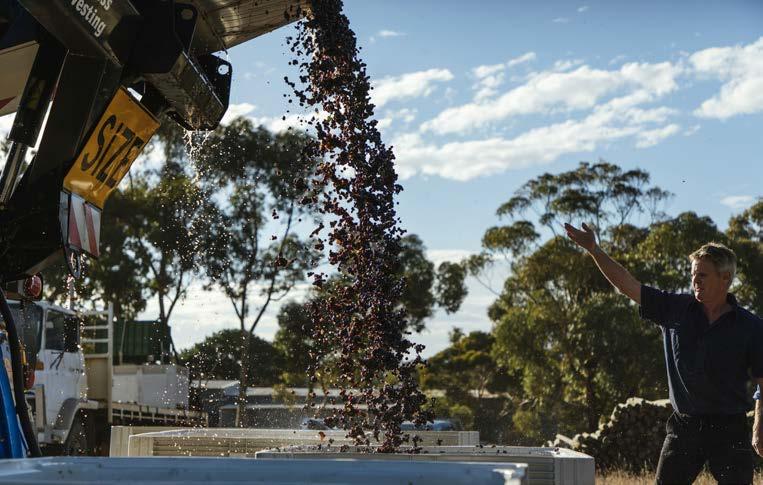





Ben Thomson
distributors have developed good working relationships with Stressless Harvesting. At times, that’s enabled significant adaptations to be made to Braud machines in order to improve their performance under Australian conditions. When the French company was able to demonstrate genuine quality increments with the introduction of new, on-board de-stemmer technology almost a decade ago, Thomson purchased the first two machines imported into Australia. The advent of Braud’s Opti-Grape system saw Thomson travel to Europe for the 2014 vintage in order to assess operation of the new innovation. The Stressless boss liked what he saw. He placed an order for two Braud 9090X harvesters, equipped with Opti-Grape and sidearm conveyors to enable harvesting and unloading on the go. Once again, Thomson’s acquisitions were the first of their kind to be employed on Australian vineyards. Subsequent performance testing of similar 9090X technology under carefully controlled and audited conditions

Stressless Harvesting managing director Ben Thomson ponders his next vintage move. Photo: Wine Australia
prompted the manufacturer to claim market leadership, with the ‘highestproductivity grape harvester ever.’ A demonstration conducted in the Riverland in March 2018 showed the machine could harvest 198 tonnes of destemmed grapes over an eight-hour period. Matter other than grapes (MOG) was calculated at barely one percent of the total pick.¹ Thomson’s experiences confirm similar high-quality yields, largely due to OptiGrape’s system of MOG removal. “Opti-Grape uses a turbine to blow a controlled air current across the intake to the 4000L on-board storage bins,” he explains. “Leaves, botrytised-fruit and other rubbish get blown over the side, leaving only clean berries and juice to drop into the bins. It’s ideal for late-picked stuff when you’ve got a lot of petioles and leaves floating about. You’re always trying to keep them out of your juice to avoid bitterness in resulting wines. This system works really well.


“It’s what our clients want. Having the capacity for de-stemming also saves time and money back at the winery because there’s no need for the process to take place there. We’re able to tip into receival bins and direct grapes straight to a fermenter. “We’re leaving stalks out in the vineyard, rather than bringing them into the winery and having to clean up and cart them away later. Winery throughput is smoother and quicker, requires a bit less labour and there are savings on equipment, power and recurrent costs like maintenance.”
Long-term familiarity with Braud technology, coupled with a fair bit of head-scratching, have enabled Thomson to work in partnership with Queensland company Precision Technology² to develop an auto-steer package for his harvesters.
“There can be a bit of an issue surrounding driver fatigue with mechanical harvesting, and while auto-steer has been available from other manufacturers for quite a while they haven’t offered what I wanted,” Thomson says. “I wanted better accuracy in machine travel; less effort in trying to keep it tracking straighter as it moves along the rows. The system we’ve developed uses GPS receivers attached to the harvester. These communicate with larger regional GPS (RTK) systems to map the angle of the harvesting machine and calculate how straight it is travelling. “If the vine row goes off the standard A-B line, the system beeps a warning signal for the operator to take their hands off the wheel and allow an auto-corrector to kick in. That pulls the harvester left or right as required, giving the driver 15-20 seconds to see what’s going on nearby in the vineyard environment. “A lot of older vineyards are not that straight, especially once you start going uphill. The set-up we’ve developed works really well on those sites.” Thomson’s own experiences³ with precision viticulture haven’t been restricted to improving the accuracy of harvester auto-steer. Somehow, he’s found headspace to ponder the vexed issue of vineyard spray application — how it can be managed more accurately and efficiently, using less water and chemical. New technology Thomson purchased in 2021 is smart by name and by nature. The Smart-Apply Intelligent Spray Control System is a density-based spray application system that utilises cutting-edge sensor and digital technologies. Developed in the USA, it can be retro-fitted to most air blast sprayers used in orchards and vineyards.
Best’s Wines managing director Ben Thomson with new Hamill Shiraz release Photo: Best’s Wines
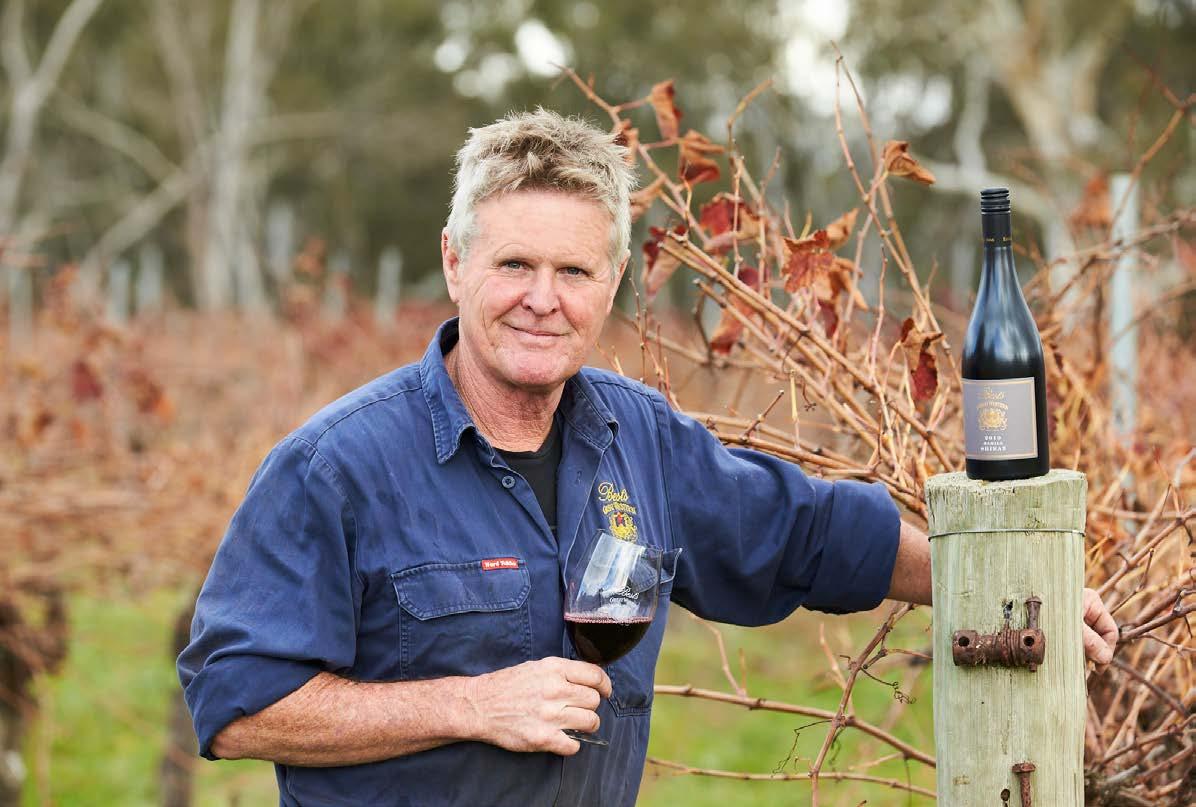

“Unlike conventional sprayers, this system uses LIDAR (Light Detection and Ranging) sensor technology to detect the specific architecture of vine canopies,” Thomson explains. “As the sprayer moves through the vineyard, it sends out a stream of laser beams that are reflected back to their source. The sensor-derived data allows an on-board computer to create a 3-D digital representation of each vine in its row. The height, width, spacing and canopy density of each plant are detected and assessed in real-time. Spray nozzles are then activated independently to deliver carefully targeted chemical application with the rate and direction required.”
Reduced spray consumption
Research and field tests in the USA indicate the technology offers effective crop protection with up to 73 per cent reduction in spray consumption.⁴ The current 2022-2023 season will provide Thomson with his first chance of using the technology through an entire vinegrowing cycle. “I think we’ve only scratched the surface with what this technology offers,” he notes. “My ultimate goal is to be able to use it in vine fertigation. Instead of fertilizing uniformly through drippers, I’d like to be able to use a spreader and apply fertiliser at rates that match each vine’s unique growing environment and various stages of phenological development. Using the technology in combination with an autonomous tractor could be a game changer.” Stop Press: Best’s 2021 Foudre Ferment Riesling was named Wine of the Year in the 2023 Halliday Wine Companion (Hardie Grant).

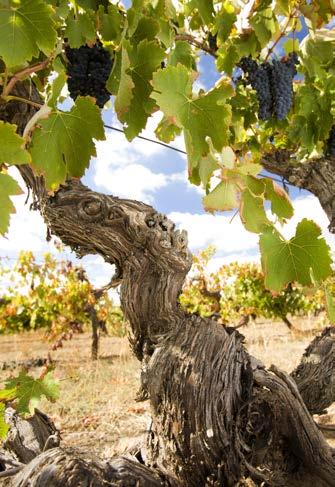
Left: Bearing fruit - 1866 Shiraz vine, Best’s Nursery Block. Photo: Visit Victoria
Right: Braud New Holland 9090X performance test support team, 2018. Photo: New Holland Agriculture


Best’s Sugarloaf Creek Vineyard

References
1. https://agriculture.newholland.com/apac/en-au/about-us/whats-up/news-events/2018/grape-harvester-performance 2. https://precisiontechnology.com.au 3. www.wineaustralia.com/news/articles/agtech-initiatives-a-growing-force 4. www.smartapply.com

INFIELD GRAPE SORTER
“Tamburlaine Organic Wines purchased the AWG sorters for Vintage 2021. We then purchased a Boom Mounted unit for Vintage 2022 . We found them easy to operate and the quality of the sample was amazing with berries and juice in the bins. We were happy with the AWG Sorters with what was achieved.”
Mark Pengilly (pictured) - Manager - Orange Vineyards, Tamburlaine Organic Wines, NSW)
Q @aussiewinegroup e: matt@aussiewinegroup.com.au ph: +61 419 959 330
aussiewinegroup.com.au
Wine Australia Verified Trial Vintage 22
• MOG levels verified from 0.02% (premium) to 0.4% (high volume) • Increase winery throughput efficiency by 23% from MOG1 to
MOG0 • No MOG related expenses at the winery • Increase grape harvest weight • Decrease juice loss through harvester fans • Models to suit any grape harvester - any vineyard • No grape maceration • No loss of harvesting speed • Easy to set up, operate and maintain • 34% reduction in Cineole compound • up to 10% increase in yield for the grower, with reduced harvester fan speed
